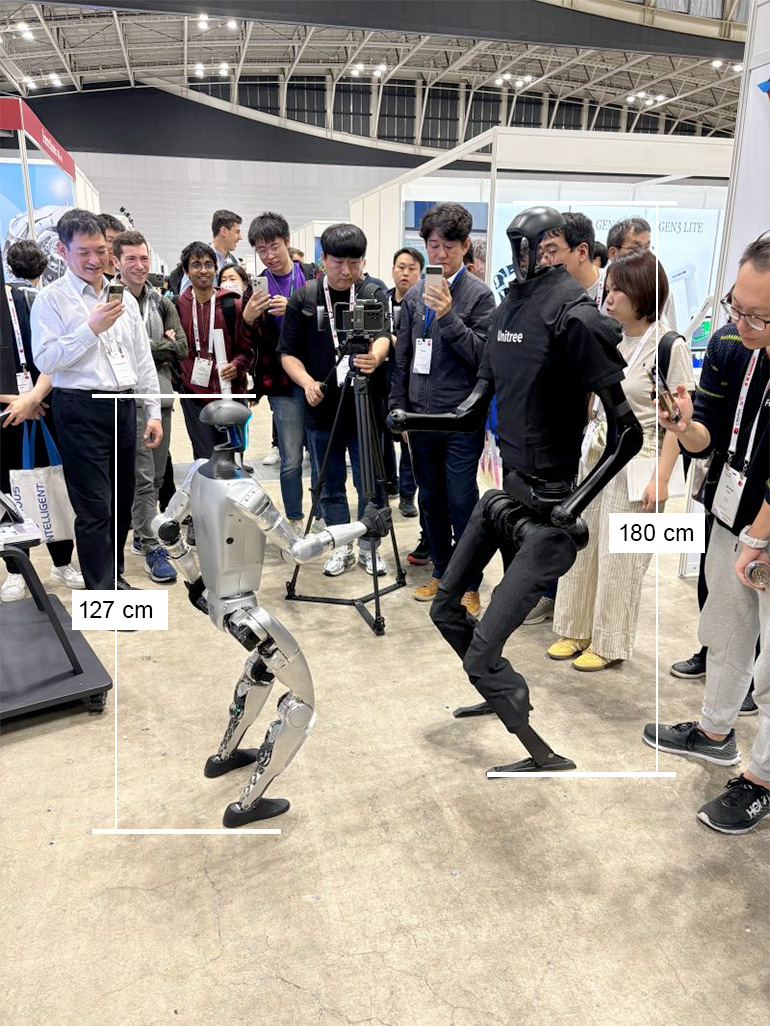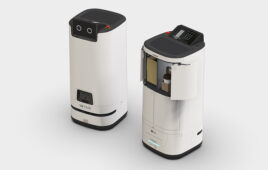|
Listen to this article
|
Unitree Robotics unveiled its latest generation G1 humanoid robot at ICRA 2024. The original Unitree H1 humanoid was first introduced in 2023 and made famous in a number of videos demonstrating its balancing and walking capabilities.
The Unitree H1 was a popular demo during the CES 2024, where the Unitree booth was slammed throughout the show. In April, Unitree brought the H1 to NVIDIA GTC and walked the robot through the crowded aisles.
Unitree has become famous in the early days of the humanoid race as the first humanoid robot to take the robot off of its tether and walk it around in public, confident in the robot’s ability to balance and stand without falling on anyone.
Unitree has been active over the last year, producing a number of videos of the H1 humanoid, often in response to marketing videos from competitors like Boston Dynamics, Agility Robotics, Tesla, Figure and Apptronik. The videos from Unitree feature human wranglers pushing, kicking, and shoving the robot to show its agility and ability to balance. This is an homage to the early Boston Dynamics Atlas videos made famous for “robot bullying.”
Unitree also showed an electric-powered humanoid doing a flip on flat ground. This was yet another homage to the famous Boston Dynamics hydraulic-powered Atlas robot doing similar athletic and parkour stunts. Notably, since it launched the H1, Unitree has attempted to set itself apart from the humanoid pack from a robot walking, running, and balancing perspective.
Enter the Unitree G1 humanoid
The first thing you notice about the new Unitree G1 humanoid is that it’s significantly smaller in size and stature than the H1 humanoid. The Unitree H1 is the size of an average adult (180 cm), while the Unitree G1 is the size of an average eight year old (127cm).
The smaller stature and design of the G1 requires less material and can use smaller motors than the H1, yet both units weigh about the same (47 kg). With a smaller robot, you’d expect to have a less expensive bill of materials. The G1 has a list price of $16,000 (base configuration) whereas the H1 has a base price of $90,000.

The Unitree G1 humanoid is shorter than its predecessor, the Unitree H1 humanoid. | Credit: Nathan Peterman
“Regarding the design and manufacturing of robots, every detail is critical in order to improve performance and reduce costs,” Unitree said when asked how it is reducing the cost of the G1 to such a low entry point. “For example, reduce the number of wires and cables, reduce the number of chips, reduce screws, etc. These may seem basic, but are actually very critical and important.
“Except for the chips, almost all the hardware of our robots is designed by ourselves. Through our past robot design and production experience, this has better performance and lower cost. Although it may seem contrary to common sense, for example, the motors and reducers are all models designed by us.”
As to whether the H1 would become obsolete with the launch of the G1, Unitree marketing director Duke Huang said, “Absolutely not. H1 is still our strongest humanoid robot and [we’ll] continue to maintain and support customers. There is a big difference between H1 and G1 in terms of size, price, and performance. G1 is more compact, more beautiful, relatively small, and easy to use and maintain. Of course, due to its smaller size, its power performance is still far behind H1.”

The Unitree G1 has a number of features and can be optioned from the entry-level unit to the fully featured version. | Credit: Unitree Robotics
According to Unitree, the G1 humanoid can be optioned with articulating, force-controlled, three-fingered hands, which can further be optioned with tactile feedback. The robot battery has an operating time of “about 2 hours” and is designed to be quickly swapped out. For sensors, the robot features 3D LiDAR and Intel RealSense D435 cameras.
The robot also features a fast walking speed of 2,000 mm/s (4.5 MPH). This is fast for any of the competing humanoids or AMRs currently on the market.
Target market for Unitree G1 humanoid
With its diminutive stature, this design decision effectively eliminates Unitree G1 from a practical human labor replacement, as it won’t be able to reach the same work envelope as a human worker. So the question remains, what market is the Unitree G1 designed for?
With its entry-level price, nimble kinematic design, large joint operating range, and optional features, the G1 might be an excellent research platform for university labs. The G1 could offer a quicker start for a lab that wants a platform for developing new embodied AI algorithms. Unitree is a NVIDIA partner, and the G1 EDU version can be optioned with an NVIDIA ORIN controller which delivers the computing power for sophisticated model development. The fact that Unitree also launched the product at ICRA, implies that R&D is the initial target application for the G1.
Due to its small size, G1 won’t be able to reach a typical workbench, kitchen, or household environment. However, foundation models developed on G1 could likely be applied to the H1 version.







Interested in ordering a robot
quite amazing
If it’s too small to do housework, it’s useless to most consumers.
So the newest top of the line autonomous robot costs less than a used car? Is he strong enough to carry me around? Pull a rickshaw maybe?
We believe this is intended for robotics researchers or enthusiasts to use as a R&D platform, etc.